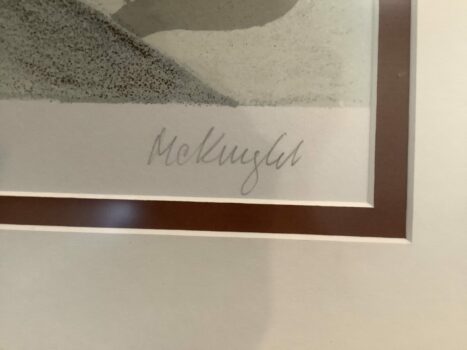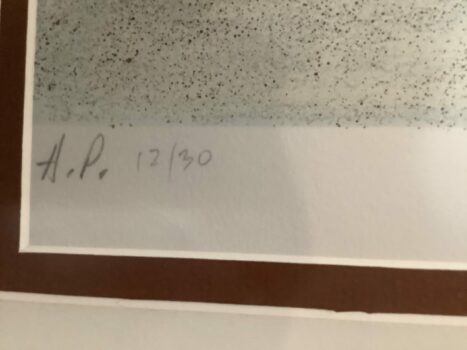Serigraph by Thomas McKnight, entitled “Fox Hunters.” 25” x 31” x 1”. pencil numbered AP 12/30 left corner; pencil signed, right corner. Nicely framed and in excellent condition. Owner purchased print at a gallery and is now deceased. Need a date of death value for September 29, 2022.
This art appraisal report offers an in-depth and impartial assessment of the artwork in question, grounded in the appraiser’s expertise and familiarity with the art market. All the information and data analyzed in this report is sourced solely from the client.
Having a clear understanding of the value of your artwork is crucial in making informed decisions about its future. This report provides a precise estimate of the value of each piece, using US dollars as the base currency. It is not intended to encourage the sale of the artwork, but rather to provide valuable information on how to proceed should the client decide to do so in the future.
Detailed description of the artwork, including its medium, dimensions, and condition.
Checking Originality: Identification with Artificial Intelligence Test
In the quest to identify a match, Image Search employs advanced AI techniques to scour databases of images in order to find visually similar images. This is achieved through the use of various algorithms such as pattern recognition and machine learning. While some results may be considered as “matches” due to a clear similarity, other results may be inconclusive as they rely more on chance rather than any specific similarities. To conduct this test, a front-facing image was used as a reference to search for similar images on the internet.
The results of the automatic recognition are not conclusive. If a match is found, it will be shown below:
What specific information can we obtain from this test?
These results show clear similarities in scene, style, and/or colors. We can’t draw a conclusion yet because this coincidence could be caused by a lot of different things, like an artist with a certain style, a copy, a limited edition print, or a regular print. I need to keep going through the research and inspection steps to get to the final conclusion.
In this case the artwork has been identified as Thomas Frederick McKnight (1941) entitled “Fox Hunters.” We can see this is a limited edition print only 30 prints were maade and this is number 12.
A limited edition print is a unique piece of art that is signed by hand by the artist who created the original painting. It is still a print, but hand signed. It is called a limited edition because the print is issued in a limited quantity and each print is numbered. As the signature is hand signed, each limited edition print is unique. In contrast to a regular print or a signed plate print, if a hand-signed print is destroyed, it can’t be replaced because the signature is unique. That’s why a limited-edition print is more valuable than a regular print.
The AP states for Artist’s Proof.
Age estimation
In order to determine the age of an artwork, such as the “Fox Hunters” painting by Thomas Frederick McKnight (1941), there are several characteristics to consider. The frame construction can provide an indication of age. For example, if the frame is constructed with a wooden moulding, it is likely from the 20th century; whereas gilded frames from the 19th century are likely to be made from plaster or composition. Additionally, the color palette used in the artwork can also help to determine its age. For instance, the use of organic pigments, which are vibrant and have a long-lasting quality, would suggest that the artwork is from the late 19th century. Furthermore, the signature of the artist can also provide a clue as to when the artwork was produced. In this case, the signature of Thomas Frederick McKnight (1941) provides a definitive answer to the artwork’s age.
Based on this information and the pictures provided, I can estimate this painting was made circa late 20th Century.
Condition of the artwork
This painting by Thomas Frederick McKnight is in excellent condition with no need for restoration. There are no appreciable damages, and if any damage is present, it is minimal. It is an Original Limited Edition Hand Signed Artist's Proof Serigraph and is a great addition to any art lover's collection.
Artist’s name, biographical information, artwork’s provenance (history of ownership) and exhibition history.

I study and research the signature of artwork to see if it matches any known signatures. At this step, I also inspect the painting’s front and back pictures, to find an artist’s name or other identifying features like stickers that may help me identify who has made this work. If there is any, provenance is also seen as an important variable because it helps figure out who the artist is.
A close picture of the signature is included in this report.
I can read the signature as:
McKnight
At this point, I can use the signature and try to find the artist’s name in a database of known-listed artists. Basically, it is a database with information about the names, surnames, origins, and biographies of the most well-known artists.
I found that the artist who painted this artwork is a listed and well known artist. Thomas Frederick McKnight (1941). Thomas Fredrick McKnight is an American artist who was born in 1941 in Kansas. After a visit to Greece, he decided to pursue art as a full-time career at the age of thirty-one. He became known for his bright, crisp colors of the Greek Islands, which were captured in his series of limited edition silkscreen prints produced in the 80s. His works were well-received and have since become sought-after by collectors.
Detailed analysis of the artwork’s style, subject matter, and significance within the artist’s oeuvre and the broader art world.
I can check if the style and type of painting match those of the artist referenced.
This painting by Thomas Frederick McKnight (1941) exhibits an artistically unique style, combining bold colors and striking composition. The style of the painting is characterized by a vibrant yet muted palette, a dynamic layering of elements, and a balanced yet dynamic composition. The use of subtle details further elevate the artist's distinct style, creating an impression of movement and energy. This beautiful and captivating original limited edition hand signed artist's proof serigraph is a unique and powerful work of art.
Comparable sales information, including prices realized at recent auctions or private sales of similar works by the artist or in the same medium.
In order to provide an up-to-date estimate of the fair market value for the limited edition hand signed Thomas Frederick McKnight serigraph entitled “Fox Hunters,” I utilized the data collected, including auction prices and other relevant market information. This is crucial as it can be used in various contexts such as insurance, estate planning, and art market analysis. It also offers a valuable insight into how the valuation of the artwork may have changed due to environmental or economic factors such as the artist's increasing popularity or the current demand for a certain style of art.
The auction prices were a significant factor in determining the current market value of the artwork, as they are based on actual transactions between buyers and sellers in the art market. As such, they are a strong indicator of the expected value of the piece in the near future.
By analyzing auction results from the last 6 months, I was able to accurately determine the current fair market value of the artwork. This approach provides a comprehensive view of how the value has changed over time and gives insight into any potential areas of appreciation or depreciation in its price. Additionally, it allows me to adjust my valuation as new auction prices become available.
Conclusion
Investing in art can be a great way to diversify your portfolio while also adding beauty to your life. Art is a tangible asset that can appreciate in value over time, and the right piece can become a family heirloom. Additionally, many works of art are considered to be a form of currency, as they can be exchanged or sold for money. Lastly, buying a piece of artwork allows you to support the artist, which can be especially important for emerging artists. Therefore, investing in art can be a great way to secure your financial future while also enriching your life.
This painting can be considered valuable by the art market because of the artist's reputation and the rarity of the piece. McKnight is a listed artist and has established a solid reputation as an accomplished painter. Additionally, "Fox Hunters" is a limited edition serigraph, meaning it was produced in a limited number of copies, making it a rare and sought-after piece. These elements make it valuable to collectors and investors interested in acquiring a rare and desirable work of art.
Final Appraisal Value ($)
1,200-1,500$
Appraisal Report made by:
Andrés Gómez
BSc, MSc, Expert Art Appraiser
10+ years of experience in Online Art Appraisals
100k+ Customers Served
Antique Store Owner
You can check my portofolio of past appraisals here:
https://www.appraisily.com/andres-portofolio/

Relevant photographs or supporting documentation, such as condition reports or expert opinions
A detailed summary of the appraisal process and the appraiser’s qualifications.
Mark-to-market art appraisal is a vital method for determining the current value of a piece of artwork. This form of valuation requires an appraiser to consider various factors, such as market conditions, the condition and age of the artwork, and the artist’s reputation. By taking all these elements into account, a mark-to-market art appraisal delivers an accurate assessment of a piece of artwork’s current market value.
The artist’s reputation, as determined by their track record in gallery and museum shows, awards, and other accomplishments, is also considered in mark-to-market art appraisal. Appraisers use this information to determine if the value of a piece is likely to increase or decrease over time. Additionally, they will inspect the condition of the artwork and note any signs of wear or damage that might affect its future resale value.
When performing mark-to-market art appraisals, appraisers also consider market conditions by researching current art market trends and comparable works that have recently sold. This information is used to provide an estimate of a piece’s worth at that point in time. By considering all of these factors, mark-to-market art appraisal is able to give a reliable indication of the current value of a work. This kind of valuation can also ensure fair prices are paid and received when buying or selling art.
In summary, mark-to-market art appraisal is a crucial tool for determining the true value of a piece of artwork, enabling buyers, sellers, and appraisers to make informed decisions regarding its worth. It takes into account multiple aspects to provide an accurate assessment of the current market value of a work. This information can be used to ensure that buyers and sellers are getting a fair price for the artwork, and that the appraiser’s valuation is up-to-date and reflective of current market conditions.
In the case of insurance replacement appraisals, mark-to-market art appraisals can also be used to accurately estimate the cost of replacing a lost or damaged artwork. The current value, as determined by the appraisal, is then used to determine the amount that the insurance company will pay back to the policyholder. This way, policyholders can rest assured that they will receive an appropriate sum for any artwork that needs to be replaced due to accidental damage or theft. Additionally, this kind of valuation helps insurers ensure they are not being overcharged when artwork needs to be replaced as part of a claim settlement.
The appraisal process is a thorough evaluation of the item or items in question. It involves researching and analyzing the information provided by the requester in order to provide an accurate estimate of its value. The appraiser takes into account factors such as condition, rarity, demand, and market prices. Photographs and detailed descriptions are especially important when providing an appraisal, since they help the appraiser identify any potential flaws or defects that could affect the item’s worth. By using all the resources that are available, an evaluation can be done quickly, efficiently, and with a high level of accuracy.
A statement of the appraiser’s liability and any potential conflicts of interest.
A qualified art appraisal, also known as a formal written evaluation, is a professional assessment of the monetary value of a piece of art by an individual who has specialized knowledge, expertise, and training in the field of art appraisal. This person must meet certain educational and professional requirements, including experience in researching and evaluating art, as well as knowledge of the art market and current market trends. The purpose of a qualified art appraisal is to provide an objective and unbiased opinion of the value of a piece of art for various purposes, including insurance claims, tax planning, estate planning, or to help determine a fair price for a sale or purchase.
We are committed to providing our clients with the most accurate and unbiased appraisal reports. To ensure impartiality, we adopt a flat rate, fixed fee structure for all appraisals, instead of a percentage-based fee. This eliminates any potential conflicts of interest between the art appraiser and the final report value. Our appraisal reports are in compliance with the Appraisal Foundation’s USPAP (Uniform Standards of Professional Appraisal Practice) standards and guidelines, which are widely accepted as the ethical and performance standards for appraisers. This guarantees that our reports are of high quality and legally defensible.
How to sell this artwork.
We have a structured guide to help you sell your artwork, you can find it here.











